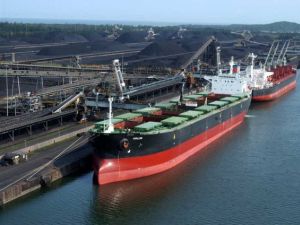
[miningmx.com] – THERE’S an interesting bit of argy-bargy in South Africa’s coal sector at the moment with the government taking steps to increase its participation in export flows and domestic pricing.
The first issue at stake is the private sector’s strangle-hold over coal exports which it controls through Richards Bay Coal Terminal (RBCT). The terminal represents the shareholder interests of listed mining firms Anglo Thermal Coal, BHP Energy Coal SA (Becsa) and Glencore Xstrata.
According to Transnet, plans for a government-owned terminal are proceeding even though RBCT’s 92 million tonne/year (mt) capacity is under-utilised.
Brian Molefe, Transnet CEO, says more details on the terminal will be published next year, but it was forecast in 2012 that the facility – known in some circles as the “ANC Terminal’ – would have an initial 12mtpa capacity.
The economic philosophy behind building a second coal terminal for South Africa, even though an existing one is under-utilised, is informed by more than two-years of discussions in which Transnet has been trying to get RBCT shareholders to release coal export “entitlement’ to emerging, black-owned coal miners – something RBCT has been reluctant to do.
“RBCT has got some elements of what typically goes wrong with concessions as smaller mines are complaining they can’t get access,’ said Molefe at Transnet’s full-year results presentation earlier this month.
“We can either fight with RBCT or create some capacity at our own terminal. So we decided to create capacity on our own,’ he said.
Mike Teke, chairperson of RBCT, says however the terminal is eager to work with Transnet. “I am extending a hand to Transnet to go the route of building 110mpta,’ he said.
The thinking is that RBCT shareholders won’t hand over entitlement where the capital has already been sunk, but it will invite Transnet to help fund its own expansion plans which Teke says will proceed undaunted.
“Our board is discussing that [the expansion] and we will consider going to 110mpta. We will also consider partnerships with TFR [Transnet Freight Rail], or any other interested parties,’ Teke added.
Say, theoretically, South Africa coal exports failed to grow from the current 70mt, that would mean a potential over-capacity of more than 50mt, or 71%, not to mention the billions of rands in wasted investment.
Coal exports are, however, expected to grow; there’s just no saying when. Commenting on lower-than-expected coal volumes in its financial year, Siyabonga Gama, CEO of Transnet division, Transnet Freight Rail (TFR) said “the jury was out’ on the rate of how quickly coal exports would grow.
“For the coal line, the jury is still out in terms of the capacity of actual exporting parties,’ said Gama. “We are fairly comfortable that we have created adequate capacity to run coal.
“In the second half of the financial year, coal prices became very depressed. There was a tendency to stockpile rather than export. We thought export volumes would be between 74mt and 75mt, but people started to hold off from November’.
The South African government is also expected to become more involved in how miners price coal supply to Eskom after the utility’s CEO, Brian Dames, complained that of the price at which electricity is sold is regulated whereas the cost of producing it was not.
“The multi-year price determination (MYPD) [the mechanism through which annual electricity tariff increases are set] presents a fundamental problem,’ said Dames. Discussions with the regulator were due on how coal costs could be contained after they formed nearly half of the 36% increase in Eskom’s total primary energy costs.
Eskom is particularly concerned where the price of coal is determined at a certain percentage above the cost of producing it, the so-called cost plus or tied mines. The structure of this arrangement means that Eskom is effectively financing the cost of the mining companies, said Eskom spokesperson, Hilary Joffe.











